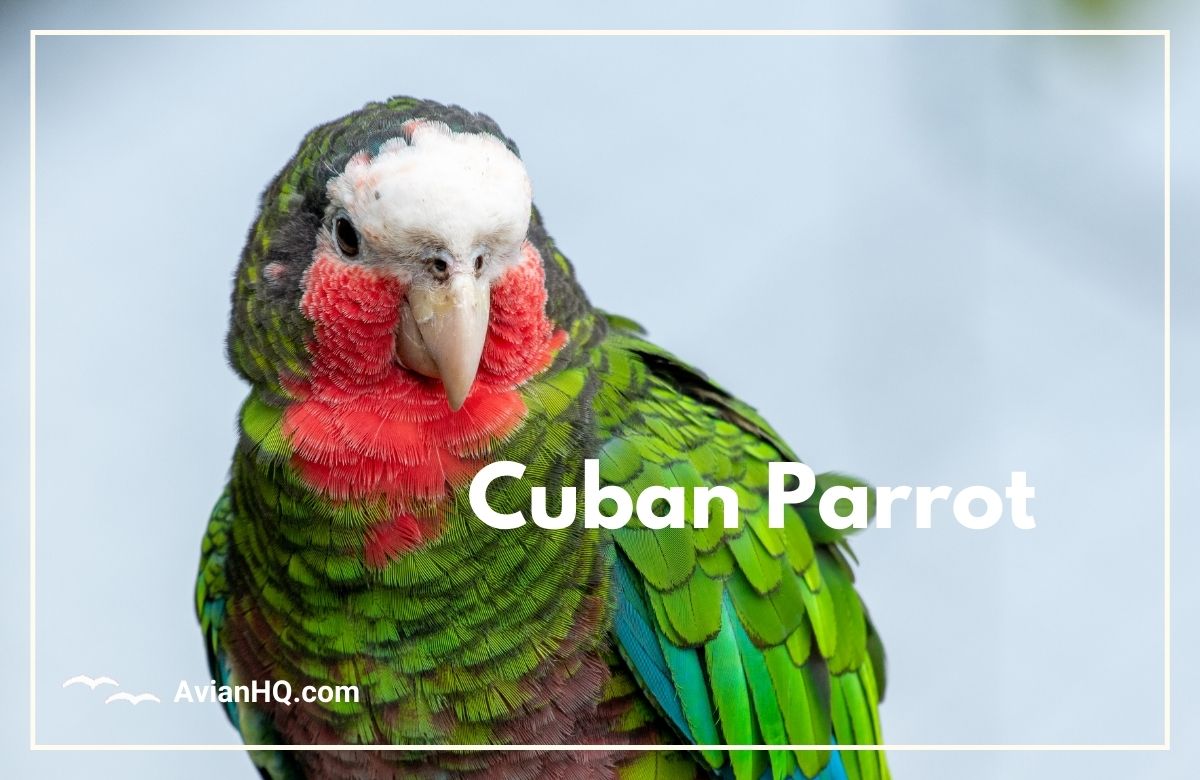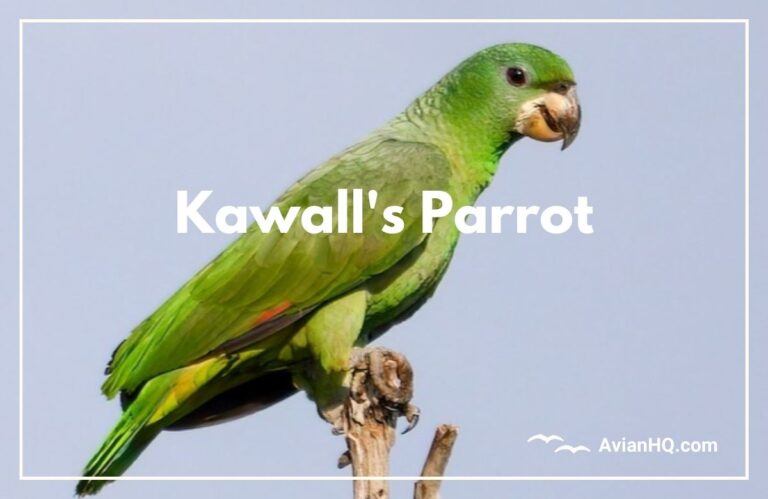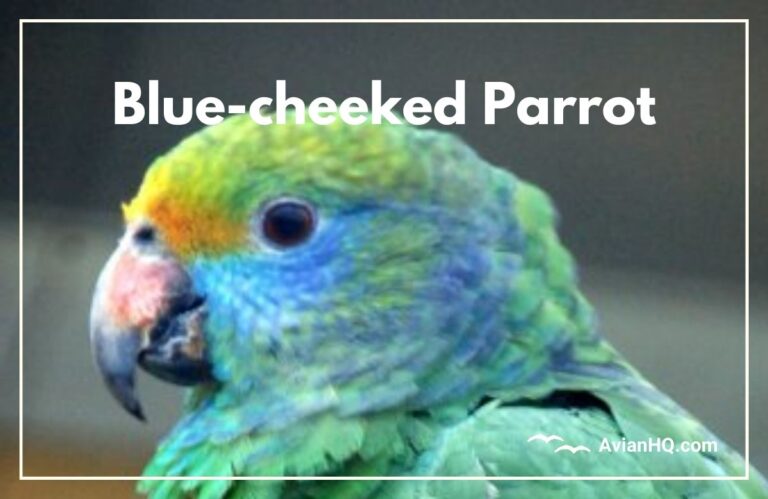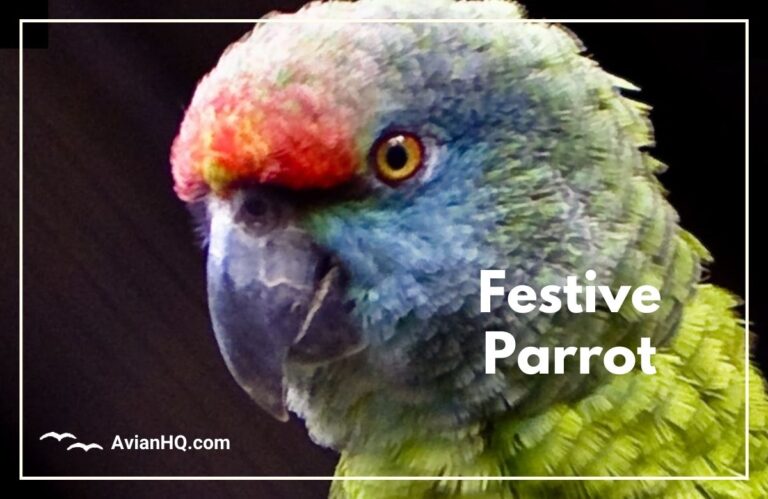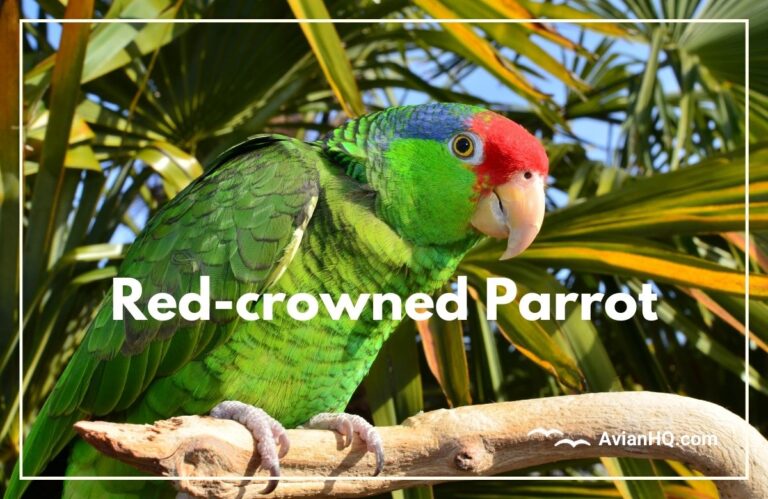Cuban Parrot (Amazona leucocephala)
The brilliant colors and vibrant personality of the Cuban Parrot (Amazona leucocephala) make this Amazon parrot stand out as one of the most beautiful in the world. Measuring about 12 to 13 inches (30 to 33 cm) from head to tail, these parrots weigh between 8 and 9 ounces (240 to 260 grams). Their bright green plumage sports a palette of colorful markings like hot pink cheeks, a red tail base, and a vibrant white and maroon head.
As their name indicates, Cuban Parrots hail from Cuba and surrounding Caribbean islands like the Bahamas and Cayman Islands. They thrive in wooded areas ranging from lush broadleaf forests to drier pine woodlands and palm groves. Living in flocks, pairs, or alone, these highly social parrots chatter constantly. Their raucous squawks and deafening screeches can erupt suddenly, then just as quickly give way to soft coos and gentle whispers.
But despite it’s beauty and boisterous nature, the Cuban Parrot population has declined substantially from habitat loss and trapping for the pet trade. Classified as Near Threatened with an estimated 20,000 to 34,000 remaining, active conservation efforts now work to preserve this species and it’s island homes.
As you learn more about this eye-catching parrot, you’ll discover what makes the Cuban Parrot a popular companion for parrot enthusiasts who adore it’s gorgeous looks and big personality. More importantly, you’ll find out how to support crucial protection programs so future generations can enjoy sightings of this exotic Caribbean bird.
History and Taxonomy
The scientific journey of classifying the Cuban Parrot began in 1758 when Swedish naturalist Carl Linnaeus first described the species. He assigned the name Psittacus leucocephalus, with the second part meaning “white-headed.” This aptly describes the distinctive white forehead and crown of the Cuban Parrot.
Over the years, scientists reclassified the Cuban Parrot under the genus Amazona, reserved specifically for Amazon parrots. it’s updated scientific name became Amazona leucocephala.
Experts now recognize 5 distinct subspecies of the Cuban Parrot, each located in different parts of the Caribbean:
- A. l. leucocephala: The nominate subspecies found in Cuba and Isla de la Juventud
- A. l. palmarum: Originally classified as a separate species, this subspecies inhabits Cuba’s Isle of Pines
- A. l. caymanensis: Only on Grand Cayman island
- A. l. hesterna: Native solely to Cayman Brac island
- A. l. bahamensis: Occurs on several Bahamian islands like Great Inagua
The various subspecies differ slightly in size and color intensity. But DNA analyses show little genetic divergence between the populations.
Physical Appearance
The Cuban Parrot cuts a striking figure with vibrant green plumage accented by colorful splashes of color on it’s head and body. It reaches an average length of about 12 to 13 inches (30 to 33 cm) from the tip of it’s tail to the end of it’s beak. Weights range between 8 and 9 ounces (240 to 260 grams).
Brilliant green feathers with black edges cover the wings, back, chest and most of the body. The forehead, area around the eyes, and crown display bright white plumage, contrasted by a hot pink band stretching across each cheek and the chin. These rosy markings vary in intensity based on the subspecies and individual.
The tail feathers shine green at the edges with vivid red central feathers peeking out from underneath. Belly feathers glow deep red or maroon, also showing variability amongst the birds. Bills match the green plumage with a greyish horn color. Dark blackish feathers top each ear. The iris or eyes shine light olive green encircled by white eye rings. Legs and feet range in color from pale pink to deep crimson.
Juvenile Cuban Parrots look similar but lack the vibrant cheek and crown patches. Their green chest and back feathers show less dark scalloping on the edges. White crown feathers often mix with pale yellow hues. The maroon belly also appears lighter or less extensive.
Habitat and Distribution
The Cuban Parrot resides on various Caribbean islands including Cuba, the Bahamas, and the Cayman Islands. Each subspecies occupies a distinct geographic range:
- Cuba: The nominate A. l. leucocephala subspecies largely inhabits forests and wooded areas across Cuba. A second subspecies, A. l. palmarum, lives solely on the Isle of Pines off Cuba’s southern coast.
- Bahamas: The A. l. bahamensis subspecies occurs on several Bahamian islands, with the largest populations on Great Inagua and Abaco. Extirpated populations once existed on other islands in the chain.
- Cayman Islands: The A. l. caymanensis subspecies only exists on Grand Cayman island, while A. l. hesterna lives solely on Cayman Brac island.
In these island habitats, Cuban Parrots frequent diverse wooded areas from pine and broadleaf forests to palm groves and mangroves. Some populations have adapted to drier habitats like agricultural areas with scattered trees. The parrots generally inhabit elevations less than 1,000 feet (300 m) but may range up to higher elevations around 3,300 feet (1,000 m).
One unique adaptation occurs with the A. l. bahamensis parrots on Abaco island. As defense against frequent pineyard fires, these parrots nest underground in limestone solution holes rather than tree cavities.
Diet and Feeding
The Cuban Parrot follows a mostly herbivorous diet in the wild, feeding on a variety of fruits, seeds, buds, and vegetation. Flocks forage energetically through their island habitats seeking out preferred foods.
Favored plant foods include:
- Fruits: wild tree fruits like figs, palms, West Indian mahogany pods, along with cultivated fruits such as mangos, papaya, banana, and pomegranate
- Seeds & Nuts: pine seeds and nuts from species like Bursera, Petitia, and Zamia
- Flowers & Buds: blossoms from trees including Avicennia and Bucida
- Leaves, Stems & Shoots: stems from vines like Cassytha and new growth shoots from trees and shrubs
The parrots often gather in large, noisy groups when feeding on abundant food sources. But they split into pairs or smaller flocks when foraging areas lack resources. Some populations also sample agricultural crops, feasting on corn, beans, rice and other cultivated foods.
In captivity, the Cuban Parrot diet aims to mimic the natural variety. A balanced mix consists of a parrot seed blend, vegetables, sprouted seeds, fresh sprouts, fruit and healthy pellets to round out nutrition.
Breeding and Reproduction
The Cuban Parrot breeding season stretches from March to September, coinciding with the annual rainy period on their Caribbean islands. As highly social birds, they nest in isolated pairs once bonded and ready to reproduce.
Most populations seek out tree cavities in mangroves, palms and other trees as ideal nesting sites. But the parrots in Abaco island and other fire-prone habitats construct underground nests in deep limestone holes for safety.
Females lay clutches ranging from 3 to 5 eggs within these protected nesting areas. Small rounded eggs measure roughly 1.3 inches x 1.1 inches (35 mm x 28 mm). Over a 26 to 28 day incubation period, the female attentively sits on her eggs until hatching.
The helpless chicks weigh just over 1/3 ounce (10 grams) at birth, covered in sparse white down. Both parents share feeding responsibilities, allowing the chicks to reach an adult weight between 8 and 9 ounces (240 to 260 grams) in their first month. At 8 weeks old, the young fledglings emerge from the nest, though they still lack the vibrant head plumage of adults.
In captivity, breeding pairs often require close monitoring since males may show aggressive tendencies towards their mate and offspring. Providing proper nesting spaces helps encourage successful breeding efforts.
Behavior and Ecology
The Cuban Parrot exhibits extremely social behaviors as part of it’s natural ecology. Outside the breeding season, they gather in large, noisy flocks that may number into the hundreds. Flocks communally roost in trees overnight.
During daylight hours, they break into small groups or pairs to actively forage across the island habitats seeking favored foods. Their raucous squawks and screeches provide constant loud chatter as they feeds. Amazingly, these deafening vocal bouts may quickly shift to soft coos and whispers then revert back to loud cries.
The parrots walk along branches using their strong beaks for balance and support if needed. Their swift, direct flight allows them to rapidly move amongst the trees.
Cuban parrots face predation mainly from birds of prey like falcons, hawks and owls who may grab an unwary adult or snatch an egg or chick from an accessible nest. Deforestation and loss of critical food trees likewise endangers the survival of existing wild populations.
Where sufficient resources exist, Cuban Parrots may gather in huge communal roosts. One study observed over 1,000 individuals departing a single roosting spot on Cuba’s Isle of Pines. Meanwhile, scientists estimate the total A. l. palmarum subspecies numbers at only 1,100 to 1,320 birds on that island.
Conservation Status
Due to ongoing threats from habitat loss, trapping, and natural disasters, the Cuban Parrot ranks as Near Threatened on the IUCN Red List of Threatened Species. Experts estimate the total worldwide population at between 20,000 to 34,000 birds across their Caribbean island homes.
The Cuban government protects the species under strict regulations allowing only sanctioned capture and exportation of a limited number of birds annually. Internationally, the Cuban Parrot falls under Appendix I status of the Convention on International Trade in Endangered Species (CITES) which prohibits commercial trade of wild-caught individuals.
Several factors continue to endanger Cuban Parrot numbers:
- Habitat Loss – Logging, agriculture, development and loss of critical nesting trees
- Trapping – For the legal pet trade as well as capture by poachers
- Natural Disasters – Hurricanes inflict severe damage and destruction to already limited habitats
Active recovery initiatives now aim to reverse the population declines on both regional and national levels. These include captive breeding programs to supplement wild stocks and projects focused on conserving remaining old-growth nesting and feeding habitat.
Ensuring the longevity of the gorgeous Cuban Parrot remains an ongoing endeavor requiring persistent conservation efforts in coordination with protective policies. But the reward will allow future generations to enjoy sightings of this iconic Caribbean parrot.
Cultural Significance
The Cuban Parrot holds a special place in the culture and history of it’s Caribbean island homes. it’s bright colors and boisterous personality captivate residents and visitors alike.
Many legends and folktales feature these charismatic parrots. In one indigenous tale, the Cuban Parrot’s distinctive white crown resulted from being clutched tightly on the head by a native chief.
During the 1800s, Cuban Parrots were exported in huge numbers as sought-after additions to European aviaries and collections. Capture for trade dramatically reduced wild populations over ensuing decades.
Today the Cuban Parrot remains a coveted pet amongst aviculturists and parrot enthusiasts. But capture quotas and permit requirements now regulate legal export off the islands. Cuban immigrants in the U.S. also highly prize these parrots.
On their native islands, Cuban Parrots stand out as iconic symbols of Caribbean forests which locals proudly feature in artwork, jewelry, watches and souvenirs for visitors. Protecting these special birds also supports heritage tourism vital to island economies.
So while much work remains to secure future populations, the Cuban Parrot continues to claim it’s niche ingrained in the cultural fabric of island life in the Americas.
Conclusion
The Cuban Parrot’s stunning visual appeal matches it’s outgoing, vocal personality. But this rare Caribbean island endemic faces an uncertain future without active conservation efforts.
As one of the most threatened Amazona parrots, effective protective strategies require coordinated policies regulating capture plus programs focused on preserving critical habitat. Reversing the Cuban Parrot’s declining population trajectory will demand substantial resources and dedication from regional wildlife officials.
However, success promises big payoffs. Viable wild populations will allow this iconic parrot to continue brightening it’s island homes with vibrant plumage and boisterous calls.
The Cuban Parrot also serves as an important indicator species. Protecting it’s vulnerable forest ecosystems safeguards habitat for numerous other Caribbean plants and animals. And by saving precious fragments of indigenous forest, conservation initiatives ultimately help protect the islands’ fresh water resources and fragile coastal zones.
With persistence from scientists, government agencies, conservation groups and local communities, the beloved Cuban Parrot should retain it’s rightful place enriching the forests and culture of the Caribbean for centuries to come.

